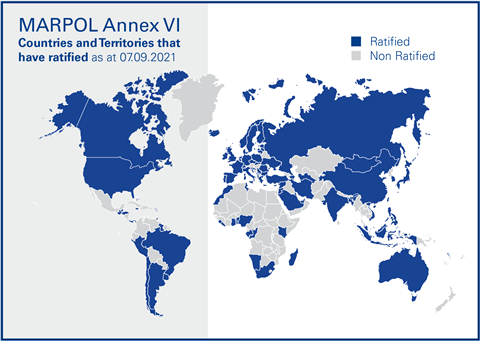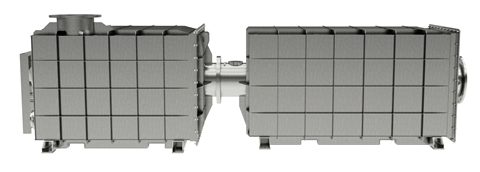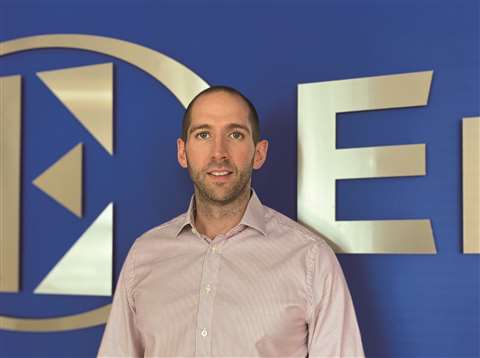Tackling challenges of marine emissions regulations compliance
30 August 2022
Fragmented nature of global requirements makes regulations hard to decipher and compliance a challenge
The global shipping industry comes under great scrutiny for the many and varied emissions regulations that pertain to it. To ascertain current requirements and what the future holds for the marine industry, Dr. David Phillips, engineering cirector, Eminox, establishes what emissions regulation compliance looks like, explores the challenges faced by the shipping industry and offers guidance on how to transition toward the global emissions reduction target.
With over 90% of world trade transported by sea, it is not surprising the emissions generated by the shipping industry make it one of the world’s largest producers of greenhouse gases (GHG). However, the fragmented nature of the global legislative requirements surrounding emissions in the marine industry does bring about a set of challenges that can be hard to decipher.
Differing stances
When it comes to emissions regulations, the marine industry has multiple organizations which regulate those emissions. The International Maritime Organisation (IMO) is perhaps the most well-known; however, the European Union (EU) and U.S. Environmental Protection Agency (EPA), among others, all have different legislative requirements.
 International Maritime Organisation MARPOL Annex VI
International Maritime Organisation MARPOL Annex VI
By the very nature of the sector, vessels are required to operate across different areas and as such must comply with those different emissions regulations, including those set by individual ports. It is this that is proving challenging for those working in all sectors of the marine industry.
The IMO, for example, in its latest Tier 3 regulations, has set ambitious goals to reduce emissions by 50% by 2050. Also, in those latest regulations, it created several Emission Control Areas (ECA) that specifically support the reduction of nitrogen oxides (NOx).
Current regulations and what they mean
It was in 2000 that IMO’s MARPOL Annex 6 was first adopted with the introduction of IMO Tier 1. Since then, each subsequent regulation, IMO Tier 2 and now IMO Tier 3, has continued the drive to lower harmful emissions generated through global shipping channels.
The latest IMO Tier 3 is an international set of standards designed to protect public health and improve air quality by controlling emissions from ships, with a specific focus in reducing NOx emissions.
All stakeholders in the shipping industry, such as ship builders, operators, owners, service providers and engine manufacturers, must consider these emissions regulations and find ways in which they can comply with the standards. One significant way is through the specification and installation of the correct exhaust system in vessels, which manages emissions and removes the harmful elements.
The variance in standards across the globe does mean that in the interim – until all vessels have transitioned to become compliant and have the necessary compliant aftertreatment systems – those working in the shipping industry must be fully aware of the regulations they are required to adhere to, wherever their vessel is located.
Other regional regulations, such as Stage 5 emissions limits for Inland Waterway (IWW) vessels, which was adopted by the European Parliament in 2016 and is a legally binding requirement since Jan. 1, 2019, bring further challenges.
For a vessel sailing across multiple legislative geographic areas, the compliance can prove to be time consuming and prohibitive to efficiency.
The challenges faced
Two challenges are the most significant:
- Differing legislation and regulations across the globe
- Llack of awareness of the latest emissions technologies
While the regulations appear to be robust, the actual compliance and enforcement is not without its loopholes.
When shipbuilders, operators and engine manufacturers are looking for solutions to meet the latest regulations (IMO 3 and Stage 5 IWW), it can be challenging to find a solution that fits with other requirements, such as not compromising available space on a vessel and concerns that emissions technologies can affect the performance of a medium-speed engine vessel.
Typically operating at between 400 and 1200 rpm, upgrading these engines with the latest emissions reduction technologies holds the short/medium/term key to making a significant impact on reducing air and water pollution from the global shipping industry.
 A complete exhaust aftertreatment system including diesel particulate filter and selective catalytic reduction components. Advanced technologies offer the flexibility of application to both new installations and the retrofitting of existing vessels. (Photo: Eminox)
A complete exhaust aftertreatment system including diesel particulate filter and selective catalytic reduction components. Advanced technologies offer the flexibility of application to both new installations and the retrofitting of existing vessels. (Photo: Eminox)
These emissions reduction technologies deliver high-performing solutions and tangible benefits. The available solutions are scalable, supporting engine output between 1 MW and 10 MW, addressing a significant proportion of the marine industry’s power range. These compact, low back pressure solutions will support engine manufacturers in producing engines that are compliant to the latest regulations.
What the solution looks like
The exhaust aftertreatment has minimal impact on engine performance, while ensuring emissions legislation compliance with far-reaching benefits.
Typical large exhaust aftertreatment systems (EATS) employ an array of square substrates forming catalyst reactor beds housed in large enclosures. Low CPSI substrates help to minimize the overall pressure drop over the system and help to reduce the risk of particulate matter causing blockages.
The main system components are a diesel oxidation catalyst (DOC), diesel particulate filter (DPF) and selective catalyst reduction (SCR), which can be used either individually or in any combination as a system to reduce carbon monoxide (CO), hydrocarbons (HC), particulate matter (PM) and NOx, all of which have been proven to detriment air quality and/or be harmful to human health.
Furthermore, and most importantly, sophisticated control solutions ensure the EATS and the engine communicate effectively, resulting in less downtime and increased performance of the vessel. Advanced technologies, such as those developed by the team at Eminox, offer the flexibility of application to both new installations and the retrofitting of existing vessels.
What does the future look like?
IMO regulations are being continuously reviewed to ensure best practice is determined across the maritime industry. Further amendments are due this year, and it is expected these will continue to drive towards the 50% reduction in emissions required by 2050.
The marine industry, and its governing bodies, clearly have the end goal in sight and it is the designers, manufacturers and installers of solutions-driven technology that can show all sectors of the shipping industry just what is possible.
With sustainability and emissions becoming a major consideration for many businesses and their environmental policies, it is reasonable to think that emissions regulations will become more visible. It is to be expected that a vision for not just meeting those regulations but exceeding them will become a factor in the decision-making process affecting all stakeholders, including the sourcing of shipping services, new vessels, retrofit systems and engine providers.
In the longer term, a transition to alternative fuel sources will be inevitable and ultimately be the change that shapes the future. Consideration should be given to the impact on emissions these fuel sources would have. In some respect, they are not as favorable as one might perceive. While they will provide a much-needed alternative to fossil fuels, and will reduce CO2 emissions, they will still pose compliance issues with current regulations. As such, emissions reduction solutions will still be required, either as an OE engine part or as a retrofit solution.
 Dr. David Phillips, engineering director, Eminox
Dr. David Phillips, engineering director, Eminox
Such alternative fuel sources could be a powerful tool in the decarbonization of the shipping industry. However, as compliance becomes ever stricter, emissions control systems will still play a huge role in removing dangerous gases from the exhaust system of marine vessels.
About the author:
Dr. David Phillips is engineering director at Eminox, which designs and manufactures exhaust aftertreatment systems. To read the full White Paper by Eminox, which continues to delve deeper into the solutions available to the marine industry, visit https://eminox.com/downloads/
STAY CONNECTED




Receive the information you need when you need it through our world-leading magazines, newsletters and daily briefings.
POWER SOURCING GUIDE
The trusted reference and buyer’s guide for 83 years
The original “desktop search engine,” guiding nearly 10,000 users in more than 90 countries it is the primary reference for specifications and details on all the components that go into engine systems.
Visit Now
CONNECT WITH THE TEAM









